Naval Radar Industry Analysis in the UK
Naval Radar Industry Analysis in the UK Size and Share Forecast Outlook 2025 to 2035
Naval radar industry analysis in the UK is projected to grow from USD 1.3 billion in 2025 to USD 1.7 billion by 2035, at a CAGR of 3.3%. S/X-band will dominate with a 47.8% market share, while active electronically scanned array will lead the technology segment with a 52.6% share.
Naval Radar Industry Analysis in the UK 2025 to 2035
The demand for naval radar in the UK is projected to grow from USD 1.25 billion in 2025 to approximately USD 1.73 billion by 2035, recording an absolute increase of USD 0.48 billion over the forecast period. This translates into total growth of 38.4%, with demand forecast to expand at a compound annual growth rate (CAGR) of 3.3% between 2025 and 2035.
The S/X-band segment is projected to account for 47.8% of UK naval radar demand in 2025. The S/X-band naval radar is widely used in the U.K. primarily because it provides an optimal balance between long-range surveillance and high-resolution target tracking, aligning with the Royal Navy’s operational needs for multi-mission versatility and adverse weather performance. Active electronically scanned array applications are expected to register 52.6% of UK naval radar demand in 2025. AESA radars excel at multi-tasking, which is vital on a warship that needs to perform many functions simultaneously
Quick Stats for UK Naval Radar Industry
- UK Naval Radar Sales Value (2025): USD 1.25 billion
- UK Naval Radar Forecast Value (2035): USD 1.73 billion
- UK Naval Radar Forecast CAGR: 3.3%
- Leading Band Type Category in UK Naval Radar Industry: S/X-band (47.8%)
- Key Growth Regions in UK Naval Radar Industry: England, Scotland, Wales, and Northern Ireland
- Regional Leadership: England holds the leading position in demand
- Key Players in UK Naval Radar Industry: Thales Group, Raytheon Technologies Corporation, Lockheed Martin Corporation, Hensoldt AG, Leonardo S.p.A.
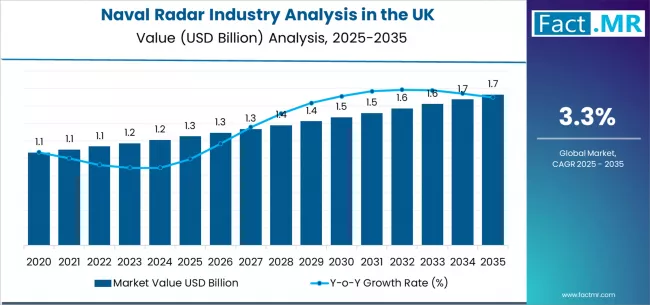
Between 2025 and 2030, demand for naval radar in the UK is projected to expand from USD 1.25 billion to USD 1.46 billion, resulting in a value increase of USD 0.21 billion, which represents 43.8% of the total forecast growth for the decade. This phase of growth will be shaped by rising naval fleet modernization preferences and surveillance technology adoption across UK naval facilities, particularly in metropolitan ports where advanced detection solutions and maritime defense standards are accelerating radar deployment. Increasing integration of professional grade applications in naval training and growing adoption of specialized detection technologies continue to drive demand. Naval operators are expanding their surveillance capabilities to address the growing complexity of modern maritime requirements and performance specifications, with UK operations leading investments in advanced naval radar systems.
From 2030 to 2035, demand is forecast to grow from USD 1.46 billion to USD 1.73 billion, adding another USD 0.27 billion, which constitutes 56.3% of the overall ten-year expansion. This period is expected to be characterized by expansion of premium radar integration, development of advanced surveillance applications and detection formulations, and implementation of specialized active electronically scanned array formulations across different naval applications. The growing adoption of maritime security principles and enhanced detection requirements, particularly in England and Scotland regions, will drive demand for more sophisticated radar systems and integrated naval platforms.
Between 2020 and 2025, naval radar demand in the UK experienced steady expansion, driven by increasing maritime security requirements in naval sectors and growing awareness of radar benefits for authentic surveillance enhancement and operational optimization. The sector developed as naval companies and maritime training providers, especially in major naval corridors, recognized the need for proven detection solutions and reliable equipment systems to achieve operational targets while meeting naval preference expectations and regulatory requirements. Radar suppliers and equipment providers began emphasizing proper quality integration and surveillance optimization to maintain competitive advantages and commercial viability.
UK Naval Radar Industry Key Takeaways
| Metric | Value |
|---|---|
| UK Naval Radar Sales Value (2025) | USD 1.25 billion |
| UK Naval Radar Forecast Value (2035) | USD 1.73 billion |
| UK Naval Radar Forecast CAGR (2025-2035) | 3.3% |
Why is the UK Naval Radar Demand Growing?
Demand expansion is being supported by the accelerating emphasis on maritime security surveillance and naval transformation nationwide, with the UK maintaining its position as a naval modernization and detection leadership region, and the corresponding need for effective fleet enhancement systems for security management, quality control processing, and performance integration. Modern naval operators rely on radar technologies to ensure operational competitiveness, surveillance compliance, and optimal pathway achievement toward maritime security operations. Advanced operational requirements necessitate comprehensive detection solutions including specialized electronic warfare capabilities, quality signal control, and security enhancement infrastructure to address diverse application needs and performance specifications.
The growing emphasis on technology adoption and increasing national and regional-level naval regulations, particularly fleet modernization programs across the UK, are driving demand for radar systems from proven surveillance suppliers with appropriate technical expertise and quality management capabilities. Naval operators and maritime training companies are increasingly investing in radar sourcing and integrated detection solutions to enhance operational profiles, access security optimization trends, and demonstrate naval leadership in competitive maritime environments. Maritime security policies and surveillance compliance requirements are establishing standardized naval pathways that require detection enhancement systems and performance assurance, with UK operations often pioneering large-scale implementation of advanced radar technologies.
Opportunity Pathways - Demand for Naval Radar in the UK
The naval radar demand in the UK is positioned for robust expansion, growing from USD 1.25 billion in 2025 to USD 1.73 billion by 2035, reflecting a 3.3% CAGR. Rising adoption of surveillance systems in fleet modernization operations, naval facilities, and maritime applications is driving growth as operators seek radar solutions that maximize detection precision and comply with stringent maritime security standards. Additionally, demand from S/X-band grade applications and advanced active electronically scanned array implementations strengthens opportunities for both sophisticated naval platforms and integrated surveillance solutions.
Operators focusing on security implementations, detection integration, and advanced electronic warfare capabilities stand to gain from evolving operational standards and customer expectations for quality processing, reliability, and surveillance optimization.
- Pathway A - Security Implementations and Fleet Modernization Applications. Fleet modernization operators face increasing demands for reliable surveillance solutions in modern naval facilities. Professional radars enable enhanced detection precision and comprehensive monitoring capabilities without compromising naval performance. Solutions targeting large-scale operators, naval companies, and modernization facilities can achieve strong adoption rates through surveillance optimization and reliability improvements. Estimated revenue opportunity: USD 0.14-0.20 billion.
- Pathway B - Detection Technology and Advanced Active Electronically Scanned Array Systems. The growth in security-conscious naval operations, surveillance optimization, and fleet operational management creates robust demand for active electronically scanned array radars ensuring precision in naval processes. Operators offering detection solutions for naval applications can build relationships with equipment suppliers and modernization integrators. Estimated revenue opportunity: USD 0.11-0.16 billion.
- Pathway C - S/X-band Grade and Professional Applications. Fleet modernization operators are increasingly adopting S/X-band systems for consistent quality control. Collaborations with equipment providers for integrated professional solutions can unlock large-volume supply contracts and long-term partnerships in precision naval applications. Estimated revenue opportunity: USD 0.09-0.13 billion.
- Pathway D - Surface Combatants and Fleet Solutions. Naval requirements and operational flexibility demands are driving preference for surface combatant radar platforms with superior surveillance capabilities. Suppliers offering comprehensive fleet solutions with exceptional operational characteristics can differentiate offerings and attract security-focused organizations. Estimated revenue opportunity: USD 0.08-0.11 billion.
- Pathway E - Submarine Operations and Maritime Applications. Critical submarine applications require specialized radar configurations with optimized surveillance features and enhanced detection properties. Operators investing in submarine development can secure advantages in serving performance-critical maritime applications. Estimated revenue opportunity: USD 0.07-0.09 billion.
- Pathway F - Service and Support Networks. Comprehensive service networks offering deployment, training, and ongoing operational support create recurring revenue opportunities. Companies building strong technical support capabilities can capture ongoing relationships and enhance customer satisfaction across naval facilities. Estimated revenue opportunity: USD 0.05-0.07 billion.
Segmental Analysis
The industry is segmented by band type, technology, and region. By band type, sales are divided into S/X-band, L/C-band, and others categories. In terms of technology, industry is segmented into active electronically scanned array and passive electronically scanned array/mechanized. Regionally, industry is divided into England, Scotland, Wales, and Northern Ireland, with England representing a key growth and innovation hub for radar technologies.
By Band Type, S/X-band Segment Accounts for 47.8% Share
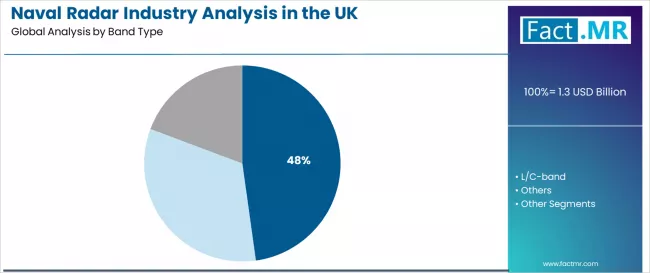
The S/X-band segment is projected to account for 47.8% of UK naval radar demand in 2025, making it the leading band type category across the sector. This dominance reflects the operational requirements and quality needs of S/X-band systems for existing fleet modernization facilities and modern applications where detection precision is optimized through standardized processing capabilities and integrated quality architecture. In the UK, where substantial naval infrastructure requires surveillance integration without complete operational replacement, S/X-band platforms provide practical pathways for detection enhancement while maintaining system continuity. Continuous innovations are improving surveillance consistency, processing characteristics, and system integration parameters, enabling operators to achieve high performance standards while maximizing operational efficiency. The segment's strong position is reinforced by the extensive existing naval infrastructure requiring technology adoption and growing availability of S/X-band technology suppliers with proven commercial experience.
- Operational compatibility and existing system integration make S/X-band platforms the preferred technology for enhancing operating fleet modernization facilities and naval installations.
- Performance reliability and commercial demonstration track records are enhancing operator confidence and project viability across large-scale deployment initiatives.
By Technology, Active Electronically Scanned Array Segment Accounts for 52.6% Share

Active electronically scanned array applications are expected to represent 52.6% of UK naval radar demand in 2025, highlighting the critical importance of advanced detection operations requiring comprehensive radar solutions. Active electronically scanned array facilities including major naval modernization centers, surface combatant operations, submarine operators, and maritime applications generate consistent demand for radar systems that are technically and economically favorable for detection applications. The segment benefits from operational characteristics that often provide superior performance insights compared to passive electronically scanned array alternatives, reducing operational complexity and enhancing capabilities. Active electronically scanned array applications also access enhanced performance optimization through technology positioning that improve detection reliability and operational appeal. In the UK, where advanced naval operations represent substantial portions of naval industry development, operational excellence requires radar integration across diverse detection operations. In England and Scotland regions, where active electronically scanned array concentrations are significant, radar demand is elevated by emphasis on maintaining operational excellence while achieving detection integration targets.
- Performance optimization and favorable application economics make this the largest technology segment for radar technologies.
- Detection precision preferences and operational requirements drive consistent demand across major naval modernization centers, surface combatant operations, submarine operators, and maritime applications.
What are the Drivers, Restraints, and Key Trends in the UK Naval Radar Demand?
UK naval radar demand is advancing steadily due to increasing detection requirements and growing recognition of security necessity for naval development, with England region serving as a key driver of innovation and application development. The sector faces challenges including competition from conventional surveillance alternatives, need for specialized integration infrastructure development, and ongoing concerns regarding supply chain complexity and implementation considerations. National naval guidelines and regional-level security initiatives, particularly detection programs in England and Scotland regions, continue to influence radar selection and deployment timelines.
Expansion of Detection Requirements and Security Standards
The enhancement of surveillance regulations, gaining particular significance through naval industry performance guidelines and security campaigns, is enabling radar suppliers to achieve differentiation without prohibitive development costs, providing predictable demand patterns through fleet requirements and operational preferences. Enhanced security standards offering substantial opportunities for radar systems and integrated applications provide foundational dynamics while allowing suppliers to secure naval agreements and maritime partnerships. These trends are particularly valuable for first-mover suppliers and premium naval development that require substantial security investments without immediate cost advantages.
Deployment of Advanced Electronic Warfare Technologies and Quality Detection Systems
Modern radar suppliers and naval operators are establishing advanced surveillance networks and centralized quality management facilities that improve operational efficiency through system standardization and economies of scale. Integration of automated electronic warfare systems, high-precision quality processing, and coordinated performance management enables more efficient radar operation across multiple naval sources. Advanced detection concepts also support next-generation maritime applications including specialized security integration, naval cluster optimization, and regional radar supply networks that optimize system-level economics while enabling comprehensive operational monitoring across naval regions, with UK developments increasingly adopting collaborative surveillance models to reduce individual operator costs and accelerate deployment.
Analysis of UK Naval Radar Demand by Key Region
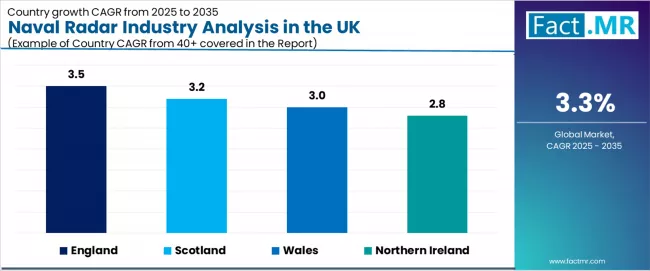
| Region | CAGR (2025-2035) |
|---|---|
| England | 3.5% |
| Scotland | 3.2% |
| Wales | 3.0% |
| Northern Ireland | 2.8% |
The UK naval radar demand is witnessing robust growth, supported by rising detection requirements, expanding security-conscious initiatives, and the deployment of advanced electronic warfare technologies across regions. England leads the nation with a 3.5% CAGR, reflecting progressive naval trends, substantial security innovation, and early adoption of premium surveillance systems. Scotland follows with a 3.2% CAGR, driven by extensive fleet modernization infrastructure, favorable naval demographics, and concentration of specialized operations that enhance application development. Wales grows at 3.0%, as naval modernization and surveillance efficiency opportunities increasingly drive radar deployment. Northern Ireland demonstrates growth at 2.8%, supported by expanding naval facilities and regional fleet initiatives.
England Leads National Growth with Innovation and Premium Naval Applications
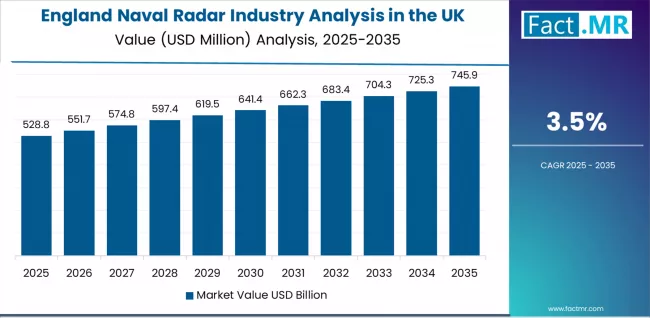
Demand for naval radar in England is projected to exhibit exceptional growth with a CAGR of 3.5% through 2035, driven by progressive naval preferences, substantial security development creating premium surveillance opportunities, and concentration of naval advancement across London and surrounding metropolitan areas.
As the dominant region with extensive fleet infrastructure and precision-focused operational policies, England's emphasis on comprehensive maritime excellence and surveillance leadership is creating significant demand for advanced radar systems with proven performance and reliable application potential. Major naval operators and radar suppliers are establishing comprehensive security development programs to support innovation advancement and premium naval deployment across diverse applications.
- Naval development trends and operational security preferences are requiring comprehensive quality management strategies and surveillance solutions, driving demand for radar systems with demonstrated performance enhancement capabilities and permanent quality assurance throughout diverse fleet modernization operations.
- Innovation ecosystem strength and naval capital availability are supporting deployment of next-generation surveillance technologies and novel application pathways that enhance commercial viability, reduce operational costs, and create new naval opportunities across security and maritime-conscious applications, positioning England as a national naval leadership region.
Scotland Demonstrates Strong Potential with Fleet Modernization Infrastructure
Demand for naval radar in Scotland is expanding at a CAGR of 3.2%, supported by extensive fleet modernization facilities including large-scale naval production, surveillance operations, and maritime companies generating concentrated demand favorable for radar systems. The region's operational characteristics, featuring substantial fleet modernization infrastructure and naval requirements ideal for surveillance integration, provide natural advantages.
Maritime expertise concentrated in Edinburgh, Glasgow, and regional naval corridors facilitates application development and operational management. Radar suppliers and operators are implementing comprehensive security strategies to serve expanding precision-focused requirements throughout Scotland.
- Fleet modernization concentration and favorable application economics are creating opportunities for specialized radar suppliers that can integrate surveillance systems with existing fleet modernization operations.
- Operational security positioning and naval awareness are building regional competitive advantages in surveillance applications, enabling comprehensive security development and maritime cluster enhancement that meets operational targets while accessing precision pricing opportunities.
Wales Maintains Strong Growth with Fleet Modernization Expansion
Demand for naval radar in Wales is growing at a CAGR of 3.0%, driven by substantial fleet modernization facilities from security operations, maritime equipment, and regional production requiring surveillance pathways.
The region's fleet modernization base, supporting critical security operations, is increasingly adopting surveillance technologies to maintain competitiveness while meeting naval expectations. Operators and radar suppliers are investing in security integration systems and regional supply infrastructure to address growing operational management requirements.
- Fleet modernization modernization imperatives and operational competitiveness concerns are facilitating adoption of radar technologies that enable continued operations while achieving security enhancement across security, maritime equipment, and production facilities.
- Naval security opportunities including regional fleet modernization development and surveillance utilization for enhanced maritime operations are creating unique regional advantages and diversified application types throughout Wales fleet modernization operations.
Northern Ireland Shows Progressive Adoption with Fleet Modernization Modernization
Demand for naval radar in Northern Ireland is advancing at a CAGR of 2.8%, supported by expanding fleet modernization facilities, regional maritime development including naval and security operations, and growing emphasis on surveillance solutions across the region.
Fleet modernization modernization and security facility expansion are driving consideration of radar systems as operational enhancement pathways. Naval companies and radar suppliers are developing regional capabilities to support emerging security deployment requirements.
- Fleet modernization expansion and operational diversification are creating economic drivers for security technologies and radar deployment across fleet modernization and maritime facilities seeking competitive differentiation pathways.
- Regional naval cooperation and coordinated maritime development are establishing consistent security environments and shared operational infrastructure that support multi-regional security projects throughout Northern Ireland fleet modernization operations.
Competitive Landscape of UK Naval Radar Demand
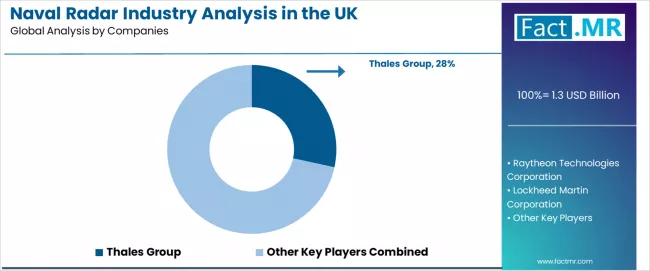
UK naval radar demand is defined by competition among specialized surveillance developers, electronic warfare technology companies, and integrated solution providers, with major naval technology corporations maintaining significant influence through innovation resources and application development capabilities. Companies are investing in radar advancement, surveillance infrastructure optimization, integration network structures, and comprehensive operational services to deliver effective, reliable, and scalable surveillance management solutions across UK fleet modernization and maritime applications. Strategic partnerships, surveillance infrastructure development, and first-mover application execution are central to strengthening competitive positioning and presence across security, maritime-conscious, and commercial surveillance applications.
Thales Group, internationally recognized surveillance leader, leads with 28.4% share, offering comprehensive radar solutions including implementation, technology, and support services with focus on fleet modernization applications, performance reliability, and cost optimization across UK operations. Raytheon Technologies Corporation, operating with extensive UK presence, provides integrated security solutions leveraging surveillance expertise, electronic warfare development, and operational management capabilities.
Lockheed Martin Corporation delivers full-service radar implementation including technology development, performance optimization, and system integration serving UK and international fleet modernization projects. Hensoldt AG emphasizes comprehensive surveillance solutions with integrated electronic warfare capabilities, quality control, and operational features leveraging fleet modernization sector expertise. Leonardo S.p.A. offers radar application development and performance optimization operations for fleet modernization and maritime applications across UK operations.
Key Players in UK Naval Radar Demand
- Thales Group
- Raytheon Technologies Corporation
- Lockheed Martin Corporation
- Hensoldt AG
- Leonardo S.p.A.
- BAE Systems plc
- Saab AB
- Elta Systems Ltd.
- Indra Sistemas S.A.
- Northrop Grumman Corporation
Scope of the Report
| Item | Value |
|---|---|
| Quantitative Units | USD 1.73 billion |
| Band Type | S/X-band, L/C-band, Others |
| Technology | Active Electronically Scanned Array, Passive Electronically Scanned Array/Mechanized |
| Regions Covered | England, Scotland, Wales, Northern Ireland |
| Key Companies | Thales Group, Raytheon Technologies Corporation, Lockheed Martin Corporation, Hensoldt AG, Leonardo S.p.A., BAE Systems plc, Saab AB, Elta Systems Ltd., Indra Sistemas S.A., Northrop Grumman Corporation |
| Additional Attributes | Sales by band type and technology segment; regional demand trends across England, Scotland, Wales, and Northern Ireland; competitive landscape with established surveillance suppliers and specialized fleet modernization developers; maritime preferences for S/X-band versus L/C-band technologies; integration with fleet modernization efficiency programs and operational optimization policies, particularly advanced in the England region |
UK Naval Radar Industry by Segments
-
Band Type :
- S/X-band
- L/C-band
- Others
-
Technology :
- Active Electronically Scanned Array
- Passive Electronically Scanned Array/Mechanized
-
Region :
- England
- Scotland
- Wales
- Northern Ireland
Table of Content
- Executive Summary
- UK Market Outlook
- Demand to side Trends
- Supply to side Trends
- Technology Roadmap Analysis
- Analysis and Recommendations
- Market Overview
- Market Coverage / Taxonomy
- Market Definition / Scope / Limitations
- Market Background
- Market Dynamics
- Drivers
- Restraints
- Opportunity
- Trends
- Scenario Forecast
- Demand in Optimistic Scenario
- Demand in Likely Scenario
- Demand in Conservative Scenario
- Opportunity Map Analysis
- Product Life Cycle Analysis
- Supply Chain Analysis
- Investment Feasibility Matrix
- Value Chain Analysis
- PESTLE and Porter’s Analysis
- Regulatory Landscape
- Regional Parent Market Outlook
- Production and Consumption Statistics
- Import and Export Statistics
- Market Dynamics
- UK Market Analysis 2020 to 2024 and Forecast, 2025 to 2035
- Historical Market Size Value (USD Million) Analysis, 2020 to 2024
- Current and Future Market Size Value (USD Million) Projections, 2025 to 2035
- Y to o to Y Growth Trend Analysis
- Absolute $ Opportunity Analysis
- UK Market Pricing Analysis 2020 to 2024 and Forecast 2025 to 2035
- Introduction / Key Findings
- UK Market Analysis 2020 to 2024 and Forecast 2025 to 2035, By Region
- Introduction
- Historical Market Size Value (USD Million) Analysis By Region, 2020 to 2024
- Current Market Size Value (USD Million) Analysis and Forecast By Region, 2025 to 2035
- UK
- Market Attractiveness Analysis By Region
- UK Market Analysis 2020 to 2024 and Forecast 2025 to 2035, By Country
- Historical Market Size Value (USD Million) Trend Analysis By Market Taxonomy, 2020 to 2024
- Market Size Value (USD Million) Forecast By Market Taxonomy, 2025 to 2035
- By Country
- Market Attractiveness Analysis
- By Country
- Key Takeaways
- Market Structure Analysis
- Competition Dashboard
- Competition Benchmarking
- Market Share Analysis of Top Players
- By Regional
- Competition Analysis
- Competition Deep Dive
- Assumptions & Acronyms Used
- Research Methodology
List Of Table
- Table 1: UK Market Value (USD Million) Forecast by Region, 2020 to 2035
- Table 2: UK Market Value (USD Million) Forecast by Country, 2020 to 2035
List Of Figures
- Figure 1: UK Market Pricing Analysis
- Figure 2: UK Market Value (USD Million) Forecast 2020-2035
- Figure 3: UK Market Value (USD Million) Share and BPS Analysis by Region, 2025 and 2035
- Figure 4: UK Market Y to o to Y Growth Comparison by Region, 2025-2035
- Figure 5: UK Market Attractiveness Analysis by Region
- Figure 6: UK Market Incremental Dollar Opportunity, 2025-2035
- Figure 7: UK Market Value Share and BPS Analysis by Country, 2025 and 2035
- Figure 8: UK Market - Tier Structure Analysis
- Figure 9: UK Market - Company Share Analysis
- FAQs -
How big is the naval radar industry analysis in the UK in 2025?
The global naval radar industry analysis in the UK is estimated to be valued at USD 1.3 billion in 2025.
What will be the size of naval radar industry analysis in the UK in 2035?
The market size for the naval radar industry analysis in the UK is projected to reach USD 1.7 billion by 2035.
How much will be the naval radar industry analysis in the UK growth between 2025 and 2035?
The naval radar industry analysis in the UK is expected to grow at a 3.3% CAGR between 2025 and 2035.
What are the key product types in the naval radar industry analysis in the UK?
The key product types in naval radar industry analysis in the UK are s/x-band, l/c-band and others.
Which technology segment to contribute significant share in the naval radar industry analysis in the UK in 2025?
In terms of technology, active electronically scanned array segment to command 52.6% share in the naval radar industry analysis in the UK in 2025.